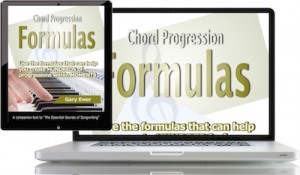Choosing the key for your song usually involves, at least in the first instance, finding the key that suits your vocal range. Most of the time this isn’t specifically a songwriting issue as much as it is a performance issue.
But there are other aspects of key choice that amounts to making a songwriting choice. For example, deciding to put your verse in one key and your chorus in a different one does have a dramatic effect on the way a song is perceived by an audience.
 “Chord Progression Formulas” show you how to create dozens of progressions in moments, using patterns and formulas. It’s easy, and the “key” ingredient for any songwriter who likes starting the songwriting process with chords. READ MORE.
“Chord Progression Formulas” show you how to create dozens of progressions in moments, using patterns and formulas. It’s easy, and the “key” ingredient for any songwriter who likes starting the songwriting process with chords. READ MORE.
Over the past more-than-a-decade of this blog I’ve written extensively about this aspect of writing. If you’ve been looking to add a bit of innovative freshness to your songwriting at least regarding key choice, I’ve listed 5 popular articles from “The Essential Secrets of Songwriting” blog below in which I’ve dealt with that issue. I hope you find them useful:
1. Key Suggestions For Song Sections
It’s not unusual for a song to change key somewhere, but keep in mind that the most common situation is actually to start and end in the same key. And some songs, like the enormously successful “Uptown Funk” (Mark Ronson, Jeff Bhasker, et al), key of D minor (D Dorian, actually), keep it very simple, featuring only two chords: Dm and G, from the beginning to the end.
2. How to Change Key in Mid-Stream
One of the most common key changes happens in the final chorus repeats, when the key is moved up a semitone, much like what you hear in “Man In the Mirror” (Siedah Garrett, Glen Ballard, recorded by Michael Jackson).
3. Downward Key Changes Might “Brighten” a Song – Here’s How
Lowering a key in the midst of a song can be tricky, for the reason that downward-moving keys can sap song energy. But there are times when changing key downward can act like a breath of fresh air. It really depends on the chord progression you use.
4. Using Abrupt Modulations to Generate Song Energy
Many modulations make use of what is called a “pivot chord.” That’s a chord that can be “seen” to be in the old key, but also as a chord from the new key. Here’s an example, with the pivot chord underlined and in bold. This progression begins in C major and ends in D major:
5. Writing a Song that Moves From Dorian Mode to Major Key
As you likely know, it’s not unusual for songwriters to create songs where the verse is in a minor key or mode (often aeolian mode), and then switch to a major key (usually the relative major) for the chorus.
I want to talk in this post about the dorian mode, which is a minor-sounding mode, and a nice alternative to the minor key or aeolian mode. To know the sound I’m talking about, play a C major scale, but start on D and end on D. You get a scale that sounds minor
 Written by Gary Ewer. Follow Gary on Twitter
Written by Gary Ewer. Follow Gary on Twitter
 If you’re looking for tons of progressions to play around with, experiment with, and use however you see fit in your songs, Gary’s written two collections: “Essential Chord Progressions”, and “More Essential Chord Progressions”. They’re part of the songwriting eBook bundle packages available at the online store. Get today’s deal!
If you’re looking for tons of progressions to play around with, experiment with, and use however you see fit in your songs, Gary’s written two collections: “Essential Chord Progressions”, and “More Essential Chord Progressions”. They’re part of the songwriting eBook bundle packages available at the online store. Get today’s deal!










